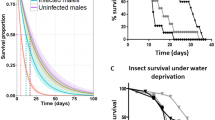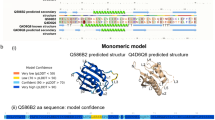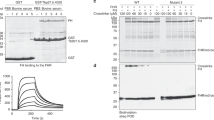Key Points
-
African trypanosomes generate chronic infections, extending over months or years, in mammalian hosts.
-
The infection profile of trypanosomes is influenced by their rate of immune evasion by antigenic variation. A further contributor to the infection profile is the rate of differentiation from proliferative slender forms to non-proliferative transmission stages called stumpy forms.
-
Recent mathematical models have demonstrated the importance of stumpy formation for infection chronicity and, together with cytological analyses, have provided a description of the temporal order of events that generate stumpy forms.
-
We propose that the interplay between antigenic variation and parasite development optimizes the ability to establish and be sustained in mammalian hosts in the field.
-
In the tsetse fly vector, trypanosomal commitment to onward differentiation and establishment is governed by a phosphatase signalling cascade that forms a novel bistable switch.
-
We propose that density-sensing mechanisms in the mammalian host are sustained by an evolutionary selection for transmission competence.
Abstract
During their life cycle, trypanosomes must overcome conflicting demands to ensure their survival and transmission. First, they must evade immunity without overwhelming the host. Second, they must generate and maintain transmission stages at sufficient levels to allow passage into their tsetse vector. Finally, they must rapidly commit to onward development when they enter the tsetse fly. On the basis of recent quantification and modelling of Trypanosoma brucei infection dynamics, we propose that the interplay between immune evasion and development achieves both infection chronicity and transmissibility. Moreover, we suggest that a novel form of bistable regulation ensures developmental commitment on entry into the tsetse fly midgut.
This is a preview of subscription content, access via your institution
Access options
Subscribe to this journal
Receive 12 print issues and online access
$209.00 per year
only $17.42 per issue
Buy this article
- Purchase on Springer Link
- Instant access to full article PDF
Prices may be subject to local taxes which are calculated during checkout





Similar content being viewed by others
References
Barrett, M. P. The rise and fall of sleeping sickness. Lancet 367, 1377–1378 (2006).
Brun, R., Blum, J., Chappuis, F. & Burri, C. Human African trypanosomiasis. Lancet 375, 148–159 (2010).
Vassella, E., Reuner, B., Yutzy, B. & Boshart, M. Differentiation of African trypanosomes is controlled by a density sensing mechanism which signals cell cycle arrest via the cAMP pathway. J. Cell Sci. 110, 2661–2671 (1997).
Reuner, B., Vassella, E., Yutzy, B. & Boshart, M. Cell density triggers slender to stumpy differentiation of Trypanosoma brucei bloodstream forms in culture. Mol. Biochem. Parasitol. 90, 269–280 (1997).
Roditi, I. & Lehane, M. J. Interactions between trypanosomes and tsetse flies. Curr. Opin. Microbiol. 11, 345–351 (2008).
Peacock, L. et al. Identification of the meiotic life cycle stage of Trypanosoma brucei in the tsetse fly. Proc. Natl Acad. Sci. USA 108, 3671–3676 (2011).
Rudenko, G. African trypanosomes: the genome and adaptations for immune evasion. Essays Biochem. 51, 47–62 (2011).
Hertz-Fowler, C. et al. Telomeric expression sites are highly conserved in Trypanosoma brucei. PLoS ONE 3, e3527 (2008).
Navarro, M. & Gull, K. A pol I transcriptional body associated with VSG mono-allelic expression in Trypanosoma brucei. Nature 414, 759–763 (2001).
Navarro, M., Penate, X. & Landeira, D. Nuclear architecture underlying gene expression in Trypanosoma brucei. Trends Microbiol. 15, 263–270 (2007).
Borst, P. Antigenic variation and allelic exclusion. Cell 109, 5–8 (2002).
Horn, D. & Barry, J. D. The central roles of telomeres and subtelomeres in antigenic variation in African trypanosomes. Chromosome Res. 13, 525–533 (2005).
Marcello, L. & Barry, J. D. Analysis of the VSG gene silent archive in Trypanosoma brucei reveals that mosaic gene expression is prominent in antigenic variation and is favored by archive substructure. Genome Res. 17, 1344–1352 (2007).
Morrison, L. J., Marcello, L. & McCulloch, R. Antigenic variation in the African trypanosome: molecular mechanisms and phenotypic complexity. Cell. Microbiol. 11, 1724–1734 (2009).
Honigberg, B. M., Cunningham, I., Stanley, H. A., Su-Lin, K. E. & Luckins, A. G. Trypanosoma brucei: antigenic analysis of bloodstream, vector, and culture stages by the quantitative fluorescent antibody methods. Exp. Parasitol. 39, 496–522 (1976).
Vickerman, K. Developmental cycles and biology of pathogenic trypanosomes. Br. Med. Bull. 41, 105–114 (1985).
Fenn, K. & Matthews, K. R. The cell biology of Trypanosoma brucei differentiation. Curr. Opin. Microbiol. 10, 539–546 (2007).
Dean, S. D., Marchetti, R., Kirk, K. & Matthews, K. A surface transporter family conveys the trypanosome differentiation signal. Nature 459, 213–217 (2009).
Robertson, M. Notes on the polymorphism of Trypanosoma gambiense in the blood and its relation to the exogenous cycle in Glossina palpalis. Proc. R. Soc. Lond. B 85, 241–539 (1912).
McLintock, L. M., Turner, C. M. & Vickerman, K. Comparison of the effects of immune killing mechanisms on Trypanosoma brucei parasites of slender and stumpy morphology. Parasite Immunol. 15, 475–480 (1993).
Engstler, M. et al. Hydrodynamic flow-mediated protein sorting on the cell surface of trypanosomes. Cell 131, 505–515 (2007).
Morrison, L. J., Majiwa, P., Read, A. F. & Barry, J. D. Probabilistic order in antigenic variation of Trypanosoma brucei. Int. J. Parasitol. 35, 961–972 (2005).
Pays, E. Pseudogenes, chimaeric genes and the timing of antigen variation in African trypanosomes. Trends Genet. 5, 389–391 (1989).
Boothroyd, C. E. et al. A yeast-endonuclease-generated DNA break induces antigenic switching in Trypanosoma brucei. Nature 459, 278–281 (2009).
Lythgoe, K. A., Morrison, L. J., Read, A. F. & Barry, J. D. Parasite-intrinsic factors can explain ordered progression of trypanosome antigenic variation. Proc. Natl Acad. Sci. USA 104, 8095–8100 (2007).
Marcello, L. & Barry, J. D. From silent genes to noisy populations-dialogue between the genotype and phenotypes of antigenic variation. J. Eukaryot. Microbiol. 54, 14–17 (2007).
Gjini, E., Haydon, D. T., Barry, J. D. & Cobbold, C. A. Critical interplay between parasite differentiation, host immunity, and antigenic variation in trypanosome infections. Am. Nat. 176, 424–439 (2010).
Seed, J. R. & Black, S. J. A proposed density-dependent model of long slender to short stumpy transformation in the African trypanosomes. J. Parasitol. 83, 656–662 (1997).
Seed, J. R. & Black, S. J. A revised arithmetic model of long slender to short stumpy transformation in the African trypanosomes. J. Parasitol. 85, 850–854 (1999).
Turner, C. M. R., Aslam, N. & Dye, C. Replication, differentiation, growth and the virulence of Trypanosoma brucei infections. Parasitology 111, 289–300 (1995).
Macgregor, P., Savill, N. J., Hall, D. & Matthews, K. R. Transmission stages dominate trypanosome within-host dynamics during chronic infections. Cell Host Microbe 9, 310–318 (2011).
Shapiro, S. Z., Naessen, J., Liesegang, B., Moloo, S. K. & Magondu, J. Analysis by flow cytometry of DNA synthesis during the life cycle of African trypanosomes. Acta Trop. 41, 313–323 (1984).
Vanhollebeke, B., Uzureau, P., Monteyne, D., Perez-Morga, D. & Pays, E. Cellular and molecular remodeling of the endocytic pathway during differentiation of Trypanosoma brucei bloodstream forms. Eukaryot. Cell 9, 1272–1282 (2010).
Barnwell, E. M. et al. Developmental regulation and extracellular release of a VSG expression-site-associated gene product from Trypanosoma brucei bloodstream forms. J. Cell Sci. 123, 3401–3411 (2010).
Jensen, B. C., Sivam, D., Kifer, C. T., Myler, P. J. & Parsons, M. Widespread variation in transcript abundance within and across developmental stages of Trypanosoma brucei. BMC Genomics 10, 482 (2009).
Florent, I. C., Raibaud, A. & Eisen, H. A family of genes related to a new expression site-associated gene in Trypanosoma equiperdum. Mol. Cell. Biol. 11, 2180–2188 (1991).
Vanhollebeke, B. et al. A haptoglobin-hemoglobin receptor conveys innate immunity to Trypanosoma brucei in humans. Science 320, 677–681 (2008).
Vickerman, K. Polymorphism and mitochondrial activity in sleeping sickness trypanosomes. Nature 208, 762–766 (1965).
Tyler, K. M., Matthews, K. R. & Gull, K. The bloodstream differentiation-division of Trypanosoma brucei studied using mitochondrial markers. Proc. Biol. Sci. 264, 1481–1490 (1997).
Tyler, K. M., Matthews, K. R. & Gull, K. Anisomorphic cell division by African trypanosomes. Protist 152, 367–378 (2001).
Brickman, M. J. & Balber, A. E. Trypanosoma brucei brucei and T. b. gambiense: stumpy bloodstream forms express more CB1 epitope in endosomes and lysosomes than slender forms. J. Eukaryot. Microbiol. 41, 533–536 (1994).
Savill, N. J. & Seed, J. R. Mathematical and statistical analysis of the Trypanosoma brucei slender to stumpy transition. Parasitology 128, 53–67 (2004).
Turner, C. M. R. & Barry, J. D. High frequency of antigenic variation in Trypanosoma brucei rhodesiense infections. Parasitology 99, 67–75 (1989).
Horn, D. & Cross, G. A. Analysis of Trypanosoma brucei vsg expression site switching in vitro. Mol. Biochem. Parasitol. 84, 189–201 (1997).
Turner, C. M. The rate of antigenic variation in fly-transmitted and syringe-passaged infections of Trypanosoma brucei. FEMS Microbiol. Lett. 153, 227–231 (1997).
Barry, J. D. et al. What the genome sequence is revealing about trypanosome antigenic variation. Biochem. Soc. Trans. 33, 986–989 (2005).
Barry, J. D. & Emery, D. L. Parasite development and host responses during the establishment of Trypanosoma brucei infection transmitted by tsetse fly. Parasitology 88, 67–84 (1984).
Van den Bossche, P. et al. Transmissibility of Trypanosoma brucei during its development in cattle. Trop. Med. Int. Health 10, 833–839 (2005).
Baylis, M. The daily feeding rate of tsetse (Diptera: Glossinidae) on cattle at Galana Ranch, Kenya and comparison with trypanosomiasis incidence. Acta Trop. 65, 81–96 (1997).
Jacobs, S. L. & Lee, N. D. Determination of citric acid in serum and urine using Br82. J. Nucl. Med. 5, 297–301 (1964).
Brun, R. & Schonenberger, M. Stimulating effect of citrate and cis-aconitate on the transformation of Trypanosoma brucei bloodstream forms to procyclic forms in vitro. Z. Parasitenkd. 66, 17–24 (1981).
Engstler, M. & Boshart, M. Cold shock and regulation of surface protein trafficking convey sensitization to inducers of stage differentiation in Trypanosoma brucei. Genes Dev. 18, 2798–2811 (2004).
Szoor, B., Wilson, J., McElhinney, H., Tabernero, L. & Matthews, K. R. Protein tyrosine phosphatase TbPTP1: a molecular switch controlling life cycle differentiation in trypanosomes. J. Cell Biol. 175, 293–303 (2006).
Szoor, B., Ruberto, I., Burchmore, R. & Matthews, K. A novel phosphatase cascade regulates differentiation in trypanosomes via a glycosomal signaling pathway. Genes Dev. 24, 1306–1316 (2010).
Kamenski, T., Heilmeier, S., Meinhart, A. & Cramer, P. Structure and mechanism of RNA polymerase II CTD phosphatases. Mol. Cell 15, 399–407 (2004).
Ferrell, J. E. Jr. Self-perpetuating states in signal transduction: positive feedback, double-negative feedback and bistability. Curr. Opin. Cell Biol. 14, 140–148 (2002).
Pomerening, J. R., Sontag, E. D. & Ferrell, J. E. Jr. Building a cell cycle oscillator: hysteresis and bistability in the activation of Cdc2. Nature Cell Biol. 5, 346–351 (2003).
Domingo-Sananes, M. R., Kapuy, O., Hunt, T. & Novak, B. Switches and latches: a biochemical tug-of-war between the kinases and phosphatases that control mitosis. Phil. Trans. R. Soc. 366, 3584–3594 (2011).
Matthews, K. R. Controlling and coordinating development in vector-transmitted parasites. Science 331, 1149–1153 (2011).
Matthews, K. R. & Gull, K. Commitment to differentiation and cell cycle re-entry are coincident but separable events in the transformation of African trypanosomes from their bloodstream to their insect form. J. Cell Sci. 110, 2609–2618 (1997).
Herman, M., Perez-Morga, D., Schtickzelle, N. & Michels, P. A. Turnover of glycosomes during life-cycle differentiation of Trypanosoma brucei. Autophagy 4, 294–308 (2008).
Opperdoes, F. R. & Szikora, J. P. In silico prediction of the glycosomal enzymes of Leishmania major and trypanosomes. Mol. Biochem. Parasitol. 147, 193–206 (2006).
Chou, S., Jensen, B. C., Parsons, M., Alber, T. & Grundner, C. The Trypanosoma brucei life cycle switch TbPTP1 is structurally conserved and dephosphorylates the nucleolar protein NOPP44/46. J. Biol. Chem. 285, 22075–22081 (2010).
Yabu, Y. & Takayanagi, T. Trypsin-stimulated transformation of Trypanosoma brucei gambiense bloodstream forms to procyclic forms in vitro. Parasitol. Res. 74, 501–506 (1988).
Rolin, S., Hancocq-Quertier, J., Paturiaux-Hanocq, F., Nolan, D. P. & Pays, E. Mild acid stress as a differentiation trigger in Trypanosoma brucei. Mol. Biochem. Parasitol. 93, 251–262 (1998).
Haanstra, J. R. et al. A domino effect in drug action: from metabolic assault towards parasite differentiation. Mol. Microbiol. 79, 94–108 (2011).
Frank, S. A. A model for the sequential dominance of antigenic variants in African trypanosome infections. Proc. Bio. Sci. 266, 1397–1401 (1999).
Ashcroft, M. A comparison between syringe-passaged and a tsetse-fly transmitted line of a strain of Trypanosma rhodesiense. Ann. Trop. Med. Parasitol. 54, 44–70 (1960).
Matthews, K. R., Ellis, J. R. & Paterou, A. Molecular regulation of the life cycle of African trypanosomes. Trends Parasitol. 20, 40–47 (2004).
Turner, C. M. The use of experimental artefacts in African trypanosome research. Parasitol. Today 6, 14–17 (1990).
Fairbairn, H. & Culwick, A. The modification of Trypanosma rhodesiense on prolonged syringe passage. Ann. Trop. Med. Parasitol. 41, 26 (1947).
Brown, S. P. & Taddei, F. The durability of public goods changes the dynamics and nature of social dilemmas. PLoS ONE 2, e593 (2007).
Oberle, M., Balmer, O., Brun, R. & Roditi, I. Bottlenecks and the maintenance of minor genotypes during the life cycle of Trypanosoma brucei. PLoS Pathog. 6, e1001023 (2010).
Morrison, W. I., Wells, P. W., Moloo, S. K., Paris, J. & Murray, M. Interference in the establishment of superinfections with Trypanosoma congolense in cattle. J. Parasitol. 68, 755–764 (1982).
Pollitt, L. C., Macgregor, P., Matthews, K. & Reece, S. E. Malaria and trypanosome transmission: different parasites, same rules? Trends Parasitol. 27, 197–203 (2011).
Pays, E., Lips, S., Nolan, D., Vanhamme, L. & Perez-Morga, D. The VSG expression sites of Trypanosoma brucei: multipurpose tools for the adaptation of the parasite to mammalian hosts. Mol. Biochem. Parasitol. 114, 1–16 (2001).
Bitter, W., Gerrits, H., Kieft, R. & Borst, P. The role of transferrin-receptor variation in the host range of Trypanosoma brucei. Nature 391, 499–502 (1998).
Xong, H. V. et al. A VSG expression site-associated gene confers resistance to human serum in Trypanosoma rhodesiense. Cell 95, 839–846 (1998).
Pays, E. & Vanhollebeke, B. Human innate immunity against African trypanosomes. Curr. Opin. Immunol. 21, 493–498 (2009).
Vickerman, K. The fine structure of Trypanosoma congolense in its bloodstream phase. J. Protozool. 16, 54–69 (1969).
Stevens, J. R. & Brisse, S. in The Trypanosomiases Ch. 1 (eds Maudlin, I., Holmes, P. & Miles, M.) 1–25 (CABI, 2004).
Gardiner, P. R. & Wilson, A. J. Trypanosoma (Duttonefla) vivax. Parasitol. Today 3, 49–52 (1987).
Nantulya, V. M., Doyle, J. J. & Jenni, L. Studies on Trypanosoma (nannomonas) congolense. I. On the morphological appearance of the parasite in the mouse. Acta Trop. 35, 329–337 (1978).
Miles, M. A. Pleomorphism demonstrated in a clone of an akinetoplastic strain of Trypanosoma evansi. Trans. R. Soc. Trop. Med. Hyg. 64, 471 (1970).
Acknowledgements
The authors are grateful to J. D. Barry for helpful comments on the manuscript and for providing useful additional insight during the preparation of the manuscript. Work in the K.R.M. laboratory is supported by the Wellcome Trust and by a Wellcome Trust Strategic Award to the Centre for Immunity, Infection and Evolution at the University of Edinburgh, UK. Work in the N.J.S. group is supported by the Wellcome Trust (grant number 082601/Z/07/Z).
Author information
Authors and Affiliations
Corresponding author
Ethics declarations
Competing interests
The authors declare no competing financial interests.
Related links
Rights and permissions
About this article
Cite this article
MacGregor, P., Szöőr, B., Savill, N. et al. Trypanosomal immune evasion, chronicity and transmission: an elegant balancing act. Nat Rev Microbiol 10, 431–438 (2012). https://doi.org/10.1038/nrmicro2779
Published:
Issue Date:
DOI: https://doi.org/10.1038/nrmicro2779
This article is cited by
-
Comparative pathogenicity of drug-resistant and drug-sensitive Trypanosoma brucei and Trypanosoma congolense infections in Nigerian local dogs
Parasitology Research (2023)
-
Slow growing behavior in African trypanosomes during adipose tissue colonization
Nature Communications (2022)
-
A receptor for the complement regulator factor H increases transmission of trypanosomes to tsetse flies
Nature Communications (2020)
-
Interspecies quorum sensing in co-infections can manipulate trypanosome transmission potential
Nature Microbiology (2017)
-
Motility and more: the flagellum of Trypanosoma brucei
Nature Reviews Microbiology (2014)



